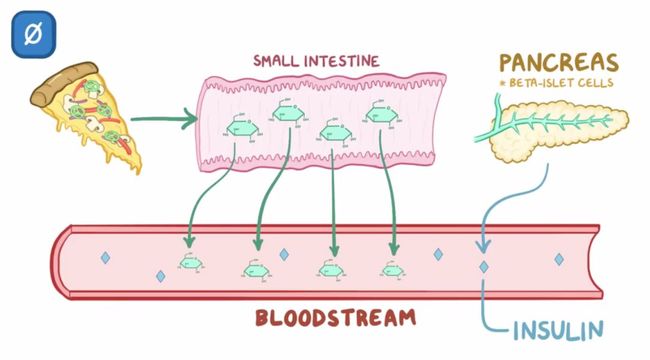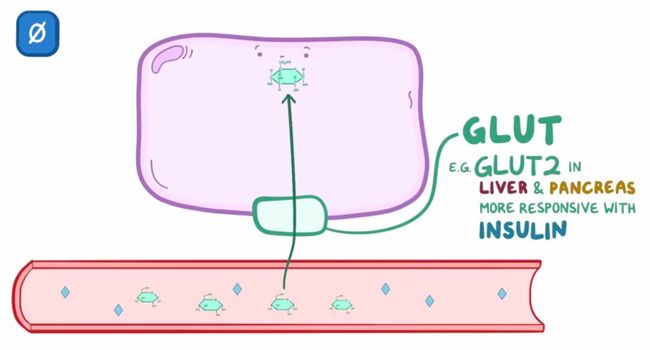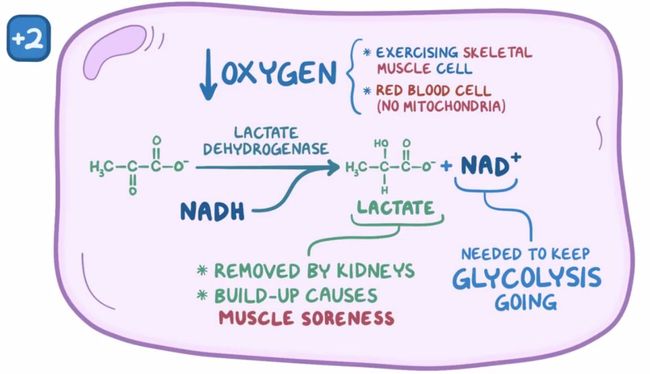【英文】Osmosis ·【翻译】冯琢熙 ·【校对】itsmelan
Let's say that you just ate a big slice of pizza with onions, mushrooms, bell peppers and Jalapeños. To pull energy out of the glucose in that pizza, or really any food, requires glycolysis.
假设你刚刚吃了一大块pizza,上面有洋葱、蘑菇、灯笼椒、墨西哥胡椒。要从pizza或是任何食物里提取葡萄糖的能量,都需要糖酵解。
Glycolysis is a series of enzymatic reactions in which glucose, a six-carbon sugar molecule, is broken down into two 3 carbon pyruvate molecules. And as glucose get processed, energy is produced in the form of adenosine triphosphate, or ATP. Now glycolysis happens in the cytoplasm of cells, and no special organelles or even oxygen are needed to turn glucose into ATP.
糖酵解是一系列酶促反应,该过程中六碳葡萄糖被分解成两个三碳的丙酮酸分子;并且,在葡萄糖的加工过程中,能量以三磷酸腺苷(即ATP)的形式产生。由于糖酵解发生在细胞质内,将葡萄糖转换成ATP的过程不需要特殊的细胞器,甚至不需要氧气。
Therefore, all cells can use glucose to make energy, and it's possible to do glycolysis even when oxygen levels are low.
因此,所有细胞都可利用葡萄糖产能,即便是低氧情况,糖酵解也可以进行。
Glycolysis can be divided into 2 phases, an energy consuming phase and an energy producing phase. It's like a business investment. This only suspenses some energy before can start making energy. And like any good investment the sale gets more energy back than it puts in.
糖酵解分为两个时期,耗能期和产能期。这就像商业投资,稳赚之前必有资金投入;和所有成功的投资一样,最终得到的利益高于投入的资金。
The energy consuming phase requires ATP, and the energy producing phase generates ATP. As well as other molecules like produce nicotinamide adenine dinucleotide, or NADH, which can be used to make ATP.
耗能期需要ATP,产能期产生ATP;同时也产生其他分子,比如NADH(可用来产生ATP)。
We can keep track of all these using an energy counter.
我们可以用一个能量计数器来追踪所有过程。
Now, going back to that delicious pizza: First, glucose from those ingredients has to get from the small intestine into the blood stream. In response to high blood glucose, the pancreatic beta cells secret insulin.
现在,让我们回到那块美味的pizza:首先,pizza不同成分里的葡萄糖必须从小肠进入血流;当血糖升高时,胰岛β细胞分泌胰岛素。
Now to get inside the cells, glucose utilizes glucose transporters, or GLUT, which are on the cell membrane. In fact, some glucose transporters like glucose transporter 2 in the liver and pancreatic beta cells, are particularly responsive to glucose in the presence of insulin.
现在我们看看胞内的情况,葡萄糖通过细胞膜上的葡萄糖转运体(即GLUT)进入细胞。事实上,一些葡萄糖转运体,例如存在于肝细胞和胰岛β细胞膜上的GLUT2,是胰岛素敏感型葡萄糖转运体。
Once glucose gets inside the cell, it's prevented from defusing a cross-cell membrane back into the circulation by enzymes called kinases which phosphorylate the glucose,
一旦葡萄糖进入细胞,为防止葡萄糖逃逸出细胞返回血液,一种叫葡萄糖激酶的酶将葡萄糖磷酸化。
Adding a phosphate group changes the shape of the glucose molecule, which means that it can't easily diffuse out of the cell, kind of like a criminal that has been handcuff to the table in the interrogation room. That added phosphate comes from the break down of the ATP into ADP and phosphate.
葡萄糖分子上加一分子磷酸基团后结构改变,意味着它不易再通过细胞膜,这很像被铐在审讯室桌子边的罪犯。那加入的一分子磷酸基团来源于ATP的分解,产生ADP和一分子磷酸基团。
So this initial phosphorylation step drops us to -1 on the energy counter
因此,第一步磷酸化使我们的能量计数器-1。
Specifically, there are two enzymes called hexokinase and glucokinase. And they both add a phosphate group to the sixth carbon in the glucose molecule, turning it into glucose-6-phosphate.
特别的是,有两种激酶,己糖激酶和葡萄糖激酶。它们都能给葡萄糖6号碳原子加一分子磷酸基团,使其转变为6-磷酸葡萄糖。
Both enzymes pretty much do the same thing, but hexokinase is found in all cells, whereas glucosekinase, like glucosetransporter 2, is induced by the presence of insulin, and is found in the liver cells and the beta-cells in the pancrease
两种酶的工作十分相似,己糖激酶存在于所有细胞中;而葡萄糖激酶,如葡萄糖激酶2,受胰岛素诱导,只在肝细胞和胰岛β细胞中被发现。
This first step is irreversible, meaning that the reaction can only go in the glucose to glucose 6-phosphate direction, and not vice versa.
糖酵解第一步是不可逆的,意味着反应只能朝着葡萄糖到6-磷酸葡萄糖的方向进行,不可逆。
Glucose 6-phosphate is then converted into its isomer, fructose 6-phosphate by an enzyme called phosphoglucoisomerase, so at this point its still a six-carbon molecule.
葡萄糖-6-磷酸接着被磷酸葡糖异构酶转换成它的同分异构体——果糖-6-磷酸,此时它仍然是个6碳分子。
Fructose 6-phosphate is then phosphorylated by the enzyme phosphofructokinase-1, or PFK1, which adds the phosphate group to the first carbon on the fructose molecule,making fructose 1,6-bisphosphate.
果糖-6-磷酸接着被磷酸果糖激酶-1(即PFK1)磷酸化;在1号碳上加一个磷酸基团,生成果糖-1,6-二磷酸。
This is the second irreversible reaction in glycolysis, and it also uses ATP as a phosphate source. So now we are at -2 on the energy counter.
这是糖酵解的第二个不可逆步骤,也需要ATP供能;因此,能量计数器显示-2。
This reaction is considered the rate-limiting step of glycolysis, meaning that the speed at which PFK1 converts fructose 6-phosphate to fructose 1,6-bisphosphate determines the speed at which all the glycolysis happens.
这一步骤(第二步)被视为糖酵解的限速步骤,意味着PFK1将果糖-6-磷酸转变成果糖-1,6-二磷酸的速率决定整个糖酵解的速率。
In other words, it's the rate limiting step of glycolysis. It's kind of like an assembling line in a factory. If the slowest step is putting tires on a car, then that's the step that determines how many cars get built in a day.
也就是说,这是糖酵解的限速步骤,这有点像工厂装配流水线;如果给汽车上轮胎是最慢的步骤,那么正是这一步骤决定一天内能装配多少辆车。
Because of this, cell closely regulate PFK1 activity by using another enzyme, called phosphofructokinase 2, or PFK2. PFK2 can also phosphorylate fructose 6-phosphate, but it adds phosphate to the second carbon instead, making fructose 2,6-bisphosphate.
因为这一点,细胞通过其他酶精确调控PFK1;这种酶叫做磷酸果糖激酶2,即PFK2。PFK2也能使果糖-6-磷酸磷酸化,但是它在2号碳上加磷酸基团,生成果糖2,6-二磷酸。
PFK2 activity varies depending on the level of glucose in the blood. When the body is well fed, like right after eating that slice of pizza, blood glucose levels go up, and the pancreas secrets insulin, which activates PFK2 and results in more fructose 2,6-bisphosphate.
PFK2活性依赖血糖浓度。当机体处于饱食状态,例如刚刚吃完那块pizza。血糖升高,胰腺分泌胰岛素,胰岛素激活PFK2,导致产生更多的果糖-2,6-二磷酸。
Here is the key to all these though, increased levels of fructose 2,6-phosphate activates PFK1, which means it increases the rate of available PFK1 enzymes. So more PFK1 means that the slowest step in glycolysis speeds up and more glucoses turning into energy. More tires means more cars.
下面是最关键的,果糖-2,6-二磷酸浓度升高激活了PFK1,意味着它提高了活性PFK1比率。因此更多的PFK1意味着糖酵解最慢的步骤加快了,更多的葡萄糖转变成能量,就像更多的轮胎能制造更多的汽车。
Now, when the body is in a fasting state, like a few hours after a meal, blood glucose levels go back down, and the pancreas secrets glucagon instead of insulin. Glucagon inhibits PFK2, resulting in less fructose 2,6-bisphosphate, which inhibits PFK1, decreasing the rate of PFK1 enzymes and that slows down glycolysis. Fewer tires, fewer cars.
当机体处于饥饿状态,比如饭后数个小时,血糖降低,胰腺分泌胰高血糖素而不是胰岛素。胰高血糖素抑制PFK2,导致果糖-2,6-二磷酸减少,抑制PFK1,降低活性PFK1比例,最终使糖酵解减慢。轮胎少,生产的车便少。
PFK1 is also inhibited in other ways, for example when cells are in high energy states, there is ton of ATP falling around as well citrate, because that's a by-product of fatty acid synthesis. Both ATP and citrate inhibit PFK1,because the cells have lots of energy and don't need to generate even more,
PFK1也被别的途径抑制,比如当细胞处于富能状态。大量ATP和柠檬酸到处乱晃(因为柠檬酸是脂肪酸合成的副产物),ATP和柠檬酸都可以抑制PFK1,因为此时细胞拥有较多能量,不需要产生更多。
Now, when cells do need energy, PFK1 becomes very active in generating fructose 1,6-bisphosphate. Fructose 1,6-bisphosphate is cleaved by the enzyme aldolase, into two 3-carbon molecules, glyceraldehyde 3-phosphate, or G3P and dihydroacetone-phosphate, or DHAP. Only G3P can go down the glycolysis pathway. So an isomerase enzyme converts DHAP into G3P.
当细胞需要能量的时候,PFK1被激活,产生果糖-1,6-二磷酸。果糖-1,6-二磷酸被醛缩酶裂解成两个3碳分子,三磷酸甘油醛(G3P)和磷酸二羟丙酮(DHAP)。只有G3P才能继续糖酵解通路,有一种异构酶将DHAP转化成G3P。
As a result for each glucose molecure, there are two G3P molecures. Each G3P is converted into 1,3-bisphosphoglycerate, or 1,3-BPG. G3P-dehydrogenase has two roles, it removes hydrogen from G3P and gives it to a nearby NAD+ molecule, making NADH as a byproduct. It also adds a phosphate group to the first carbon of G3P, making 1,3-BPG.
结果,一个葡萄糖分子可以产生两个G3P;每个G3P 转变成1,3-二磷酸甘油酸,即1,3-BPG。G3P脱氢酶有两个作用,一是使G3P脱氢,脱下的氢给邻近的NAD+分子,生成副产物NADH。二是给G3P的1号碳加磷酸基团,产生1,3-BPG。
Now, since there are two G3P molecules, this happens twice, resulting in two NADH molecules. Each NADH molecule enters the electron transport chain in the mitochondria and goes on to make roughly three ATP each.
好了,既然我们有两分子G3P,这个过程就要发生两次,结果产生两分子NADH。每个NADH经过线粒体上的电子传递链,大概能产生3分子ATP。
Now, an enzyme called phosphoglycerate kinase removes a phosphate from the first carbon of 1,3-BPG and gives it to ADP making 3-phosphoglycerate and ATP as a byproduct. So add two more ATPs to our counter because this reaction happens twice. So now we're back at zero.
磷酸甘油酸激酶除去1,3-BPG1号碳上磷酸基团,产生3-磷酸甘油酸和副产物ATP。因为上述过程发生两次,我们在计数器上+2。现在,计数器又回到0。
Next, an enzyme called mutase moves the phosphate on 3-phosphoglycerate to the second carbon, making 2-phosphogycerate. After that, an enzyme called enolase removes a water molecule from 2-phosphoglycerate, and makes phosphoenolpyruvate, or PEP.
接下来,转位酶将3-磷酸甘油酸中的磷酸基团转移到2号碳上,产生2-磷酸甘油酸。之后,烯醇化酶去除2-磷酸甘油酸中的一分子水,产生磷酸烯醇式丙酮酸,即PEP。
Finally the enzyme pyruvate kinase transfers the phosphate from PEP to ADP, making pyruvate and ATP as a byproduct.
最终,丙酮酸激酶将PEP上的磷酸基团转移到ADP上,产生丙酮酸和副产物ATP。
This is our third and last irreversible reaction of glycolysis. And again we'll add two ATPs to our counter because this reaction happens twice. As it turns out, pyruvate kinase is also regulated by the cell.
这就是糖酵解中第三个,也是最后一个不可逆步骤。同样由于上述过程发生两次,我们再向计数器上加2个ATP。事实证明,丙酮酸激酶受细胞调控。
Interestingly, fructose 1,6-bisphosphate upregulates pyruvate kinase, a process called feed-forward regulation. Because its kind of like one enzyme priming another one because it's clear that things are about to get busy.
有趣的是,果糖-1,6-二磷酸能上调丙酮酸激酶,这个过程叫做正反馈。因为这有点像一种酶引发了另一种酶,因为很明显,接下来要开始忙活起来了。
On the other hand, high levels of ATP and amino acid alanine down regulate pyruvate kinase avtivity. Alanine comes from skeletal muscle breakdown when fasting, and it's used as a substrate for making new glucose. So high levels of alanine signify that the body needs to make new glucose,not break it down in glycolysis.
另一方面,高水平ATP和丙氨酸会下调丙酮酸激酶。丙氨酸来自饥饿时骨骼肌分解。它可以作为糖异生的原料。
Once pyruvate is made, glycolysis is pretty much over until this point the process is worked without the need of oxygen, so glycolysis is considered anaerobic. And to this point, we've generated a total of 2 ATPs in the process, so although this is a good investment, it's not a great investment.
丙酮酸一旦形成,糖酵解就快要结束了。直到现在,整个过程不需要氧气。因此糖酵解被认为是无氧的。迄今为止,我们已经总共产生2分子ATP,这是一个有利的投资,却不是一个暴利的投资。
Fortunately, though, most cells have mitochondria, and have access to oxygen, because that's where the pay-off really becomes obvious. That's because pyruvate can enter the mitochondria in participate in the Krebs circle also called the citric acid cycle, as well as the electron transport chain, or to make more ATP. And in the end after all the mitochondria reactions, you'll end up with the net total of roughly 30-32 ATPs.
幸运的是,大部分细胞都含有线粒体并且能接触到氧气。这才是收益(产能)最多的地方。那是因为丙酮酸可进入线粒体,进入Krebs circle(也叫三羧酸循环),和电子传递链,制造更多的ATP。最终,经过所有的线粒体内反应,总计净得到约30-32分子ATP。
Now, some cells don't have access to suficient oxygen, like an exercising skeletal muscle cell, or red blood cell that lacks mitochondria. In those situations, the cell can use the enzyme lactate dehydrogenase to remove hydrogen from NADH molecule and give it to pyruvate, making lactate and NAD+ as a byproduct. NAD+ is crucial bacause it is needed to work with G3P dehydrogenase and keep glycolysis going.
由于有些细胞接触不到充足的氧气,像正在收缩的骨骼肌细胞,或者缺少线粒体的红细胞。在这些情况下,细胞可利用乳酸脱氢酶将NADH的氢脱去,给丙酮酸,产生乳酸和副产物NAD+。NAD+非常重要,因为G3P脱氢酶和糖酵解过程的继续都离不开它。
Now, normally lactate is removed from our blood by the kidneys, but if local lactate levels rise too quickly, it can sometimes build-up and this is what's responsible for some of the muscle soreness you develop when you exercise.
一般乳酸经肾排出体外,但是如果局部乳酸水平增长过快,乳酸有可能累积。这就是为什么运动之后肌肉会酸痛。
Alright, as a quick recap, glycolysis breaks down a six-carbon glucose molecule into two three-carbon pyruvate molecules without the use of any organelles or oxygen. Over all there is a net production of 2 ATP and 2 NADH molecules, which in the mitochondria make roughly 3 ATPs per NADH.
好的,我们来快速复习一下,糖酵解把一个6碳的葡萄糖分子裂解成两个3碳的丙酮酸。该过程不需要任何细胞器和氧气;总计净生成2分子ATP和2分子NADH,每分子NADH可以在线粒体中产生约3分子ATP。
还是在老地方打医学词汇小怪兽呀 quizlet.com/_64aliz













